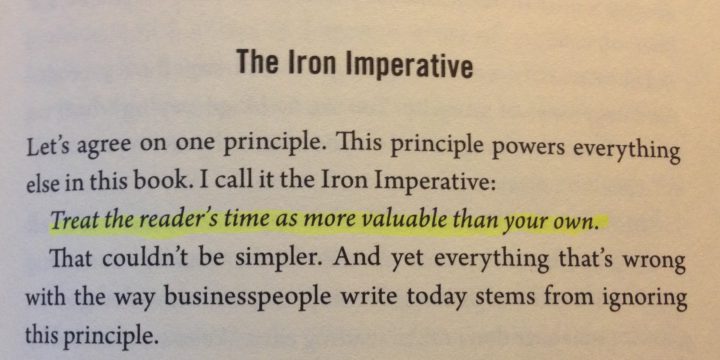Lean Communication Applied to Writing
Your time is more valuable than mine, so I’ll get right to the point: I recommend that you read Writing Without Bullshit, by Josh Bernoff.
Because so much of your business communication consists of words on screen or paper, you have to be able to write lean if you want to be a complete lean communicator. That’s because even though lean thinking applies equally to spoken or written communication, writing poses its own challenges that require specialized approaches.
How is writing different?
The principal difference between writing and speaking is that written communication is asynchronous, which is a fancy way of saying that production and delivery of the message don’t happen at the same time. That can help or hurt your communication.
It can help because usually the first time you say something, you don’t say it as well as you could. Writing is like a ballistic missile: you can choose your target and take pains to aim properly. You can take time to think carefully about what you want to say and choose your words, and you can edit and polish as much as you want. On the receiving end, the reader can absorb your message at their own pace, re-reading if they have trouble understanding or skimming over parts that they already know.
It can hurt because if you’re off target, you don’t have the feedback loop of real-time dialogue which allows you to adjust, clarify and take in the listener’s viewpoint to improve your original message. Plus, if you write the way you were taught in school, you’re almost guaranteed to produce crappy writing. That’s because the sole purpose of writing in school is to make yourself look smart, not to help the reader improve their outcomes.
That presents a great opportunity for a good writer. Since most business writing is bland, boring or baffling, you can easily stand out and make a reputation for yourself by just being a little better than everyone else. Unfortunately most people throw away the advantages of writing by not taking the time to carefully craft and edit their message, so the bulk of business writing is full of waste, or to use the more colorful term: bullshit.
So what?
Fortunately, Writing Without Bullshit supplies the antidote. If I were to write a book on Lean Communication as applied to writing (and if I were a better writer), this is the book I would have tried to write.
So much of what Bernoff writes aligns closely with LC principles. That’s no coincidence, because a lot of my LC ideas have come from studying and trying to apply ideas from books on writing. Lean keys such as outside-in thinking, Bottom Line Up Front, and Transparent Structure all apply as well to writing as they do to speaking. But this book brings a writer’s perspective to the principles.
Let’s just focus on one his Iron Imperative, which you see reflected in the picture above this post:
Treat the reader’s time as more valuable than your own.
That’s Outside-In Thinking, applied to writing. It’s powerful because it focuses your mind on adding value to the reader without wasting their time. If you stick a post-it note with it on the top of your computer screen, it will remind you to take the time and make the effort so that your reader won’t have to, and it will hugely improve your writing[1].
Actually, that’s not exactly true. You will throw away the advantage you have as a writer if you don’t take the time and make the effort to carefully craft your message and choose your words. That’s why the second half of the book is so valuable. It’s about the project management aspect of writing, and it will teach you how to be productively paranoid, find your flow, and edit your own and others’ work effectively.
The nice thing about becoming a better writer is that it will make you a better speaker as well. So if you truly want to add value with less waste no matter what medium you use, you must learn to get rid of the bullshit. You—and the rest of the world—will be better off.
[1] I would be guilty of peddling bullshit myself if I didn’t disclose some disagreements I have with Bernoff. While I agree with his Iron Imperative, I don’t believe it says enough about understanding the reader’s perspective and their needs. If the purpose of business writing is to change the reader, as he says, then one should think more deeply about the WIFM when writing.





